In a remote mining corridor in Peru, a mining association called AMATAF is on a mission to change the face of gold mining in the Amazon.

It’s a daunting task. According to the Peruvian Ministry of Environment, artisanal and small-scale gold mining in Madre de Dios, Peru, has released more than 3000 tons of mercury into the environment over the past 20 years, poisoning local communities and provoking global concern about gold’s environmental impact.
Nonetheless, gold mining remains the most important economic activity in Madre de Dios, where some 30,000 depend on it. AMATAF, founded in 1987 by a coalition of low-income farmers, is one of the few artisanal mining associations working legally in the buffer zone surrounding the Tambopata National Reserve, a rich oasis of biodiversity. Recognizing the need for change, AMATAF has been working with Pure Earth to innovate what they call a “cleaner and more responsible” form of mining.
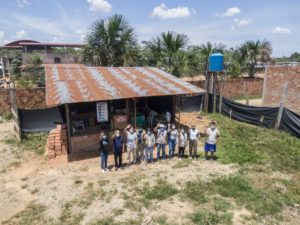
With Pure Earth’s help, AMATAF reforested over 5 hectares of degraded land in 2021 (read the story on the first of two reforestations here). Along the way, Pure Earth and project partner CINCIA trained AMATAF leaders in reforestation methodology, an essential step to being able to ecologically close mined-out areas of their association.
AMATAF then began tackling the next big challenge: how to recover gold without mercury and, just as importantly, how to market it.
For this, Pure Earth recruited two key partners: CITE Minero, a Peruvian institution dedicated to promoting clean mining techniques, and Andrea Jose Castro, a Peruvian jeweler and longstanding collaborator with Pure Earth.
CITE Minero and the Art of the Shaking Table

In January 2021, CITE’s technicians and Pure Earth Coordinator France Cabanillas visited the Linda II Mining Concession in AMATAF, the same concession where Pure Earth had conducted reforestation in early 2020.
Like many in the region, miners from Linda II practice alluvial mining. They operate small barges that suction slurry from pools hollowed out by high-pressure hoses. They then pass the slurry through a chute and carpet, which captures heavier particles. The miners wash and shake the carpets to obtain a refined, gold-bearing concentrate. At this point, miners typically mix the concentrate with mercury, forming an amalgam that is then burned to purify the gold.
After taking ore samples and running a lab analysis, CITE concluded that miners from Linda II were losing about 60% of gold in the first stage of processing, and another 50% during mercury amalgamation. To CITE, these losses represented a big opportunity for AMATAF to become both more lucrative and environmentally responsible.
During the visit to AMATAF, CITE discovered something else–a shaking table, a technology that Pure Earth has tested at other sites to help miners recover gold mercury fee. AMATAF had purchased the table years ago but never received training on how to properly operate it. When it fell into disrepair, no one knew how to fix it and the table was left languishing in storage.
After assessing its condition, CITE recalibrated the table in September 2021 and managed to recover about 80% of gold from concentrated ore, a rate 30% higher than what miners were getting with mercury.
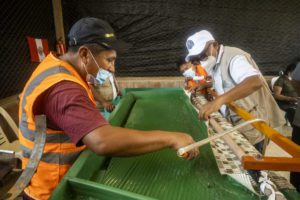
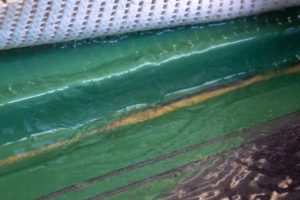
Convinced of its potential, five concession owners from AMATAF participated in a training course developed by CITE in the operation, safety, and maintenance of the shaking table. Among the participants were Hugo Quispe, owner of the Linda II Concession, Vilma Contreras, President of AMATAF, and Khaled Celadita, Vilma’s son and the one who will be the primary operator of the table.
After passing tests, participants received awards during a closeout ceremony in October 2021, attended by a range of stakeholders and Madre de Dios Governor Luis Hidalgo.
“Using clean technologies, we can improve production and advance in formalization that will generate resources for the region,” remarked Governor Hidalgo during the event.

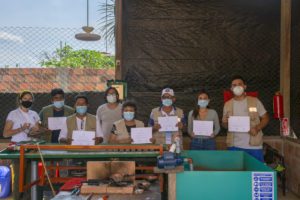
Andrea Castro and the Art of Marketing Clean Gold
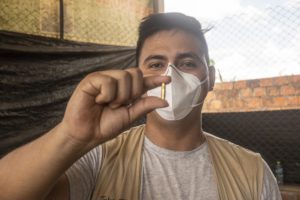
Even though AMATAF was ready to produce mercury-free gold, they still faced a big challenge: how to sell their new product in the local, national, and international market.
Surprisingly, local gold shops distrust the fine gold produced by shaking tables, preferring the familiar mercury-marked gold rocks sold by most miners in the region.
Fortunately, Pure Earth has encountered this challenge before. We’ve found that the best solution is to help miners make their gold shinier and more marketable. For this, the team works with Andrea Castro, a Peruvian jeweler who made the first purchase of mercury-free gold from the Peruvian Amazon for the international market from Pedro Ynfantes, a miner Pure Earth trained to go mercury-free.
Andrea had made the journey to Don Pedro’s mine personally to show him how to transform his mercury-free gold into something more locally and internationally marketable. In late October 2021, Andrea returned to the Amazon to bring this technique to AMATAF concessionaires in a two-day workshop.
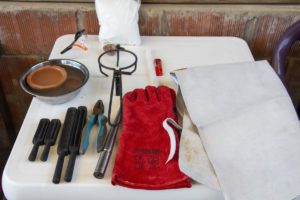
On the first day of the training, participants learned to smelt gold with borax using simple welding tools already owned by a typical miner.
Andrea demonstrated the steps, beginning by treating the crucible (the clay bowl pictured above) with water to prevent cracks during smelting. She then placed mercury-free gold into the crucible and sprinkled it with borax to lower the melting temperature. Finally, she used a blowtorch to smelt the gold, casting it into an ingot or sheet using the instruments pictured above. Participants produced three pieces during the workshop, about 40 grams of gold in total.
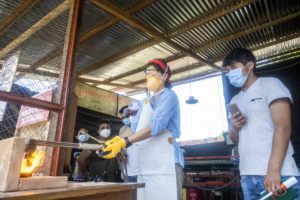
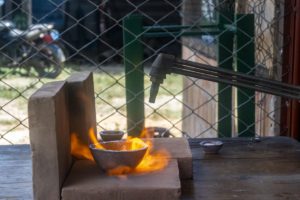
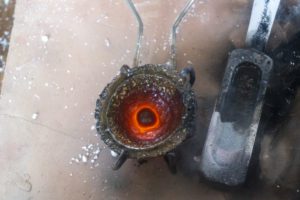
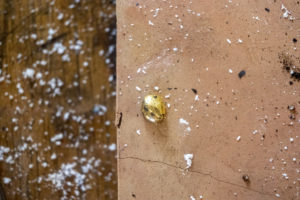
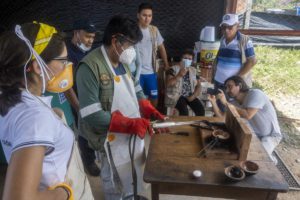
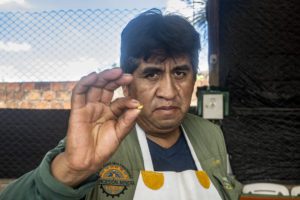
On the second day, Andrea and her partner presented miners ways to commercialize mercury-free gold, including how to advertise it, where to sell it, and how to comply with legal requirements. As a bonus, Andrea even taught miners rudimentary ways to make their gold into jewelry using a special hammer set.
The training concluded with a practical demonstration, in which each participant smelted mercury-free gold and obtained a shiny, finished product. After the training, a closeout ceremony was held and each participating miner was awarded a certificate.
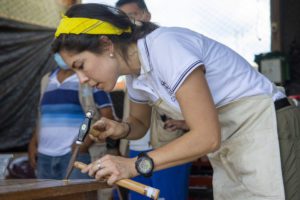
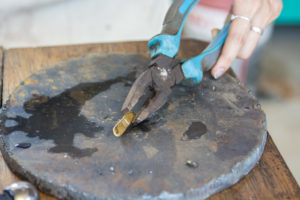
Next Step: Reaching Fairmined Certification
AMATAF’s journey towards a more responsible form of gold mining is a huge stride for the region. Nonetheless, despite their knowledge and dedication, mercury-free mining groups like AMATAF still struggle to find consistent demand for their clean gold.
Fortunately, Pure Earth’s work with AMATAF has attracted attention from other NGOs. In collaboration with Pure Earth, the Alliance for Responsible Mining (ARM) is now working with AMATAF to pursue a Fairmined Certification and attract an international market to the region. This effort is supported by the Brilliant Earth Foundation.
“… Through this Eco-Fairmined certification, we will be able to facilitate AMATAF’s direct access to Brilliant Earth customers and send a clear message that responsible mining investments and social and environmental protections are important to everyone,” says Beth Gerstein, CEO of Brilliant Earth, as reported in the Responsible Jewelry Council industry newsletter.
AMATAF is doing its part. Now it will be up to international buyers to reward them for their hard work and help forge a healthier future for the Amazon.
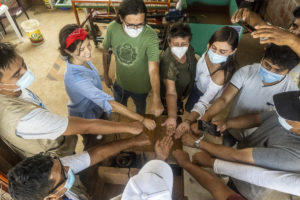
Pure Earth would like to thank Brilliant Earth for its continued support; and The Tiffany & Co. Foundation for its support of community-led reforestation in the Peruvian Amazon and for support to train artisanal gold miners in mercury- free mining methods.
This article is by Charles Espinosa for Pure Earth.



